Morris County, Kansas
Morris County (standard abbreviation: MR) is a county located in the U.S. state of Kansas. Its county seat and largest city is Council Grove. As of the 2020 census, the county population was 5,386.[1] The county was named for Thomas Morris, a U.S. Senator from Ohio and anti-slavery advocate.
Morris County | |
|---|---|
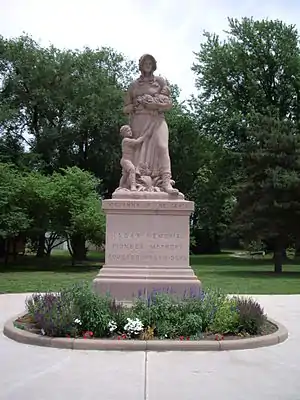 Madonna of the Trail monument in Council Grove | |
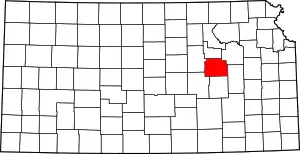 Location within the U.S. state of Kansas | |
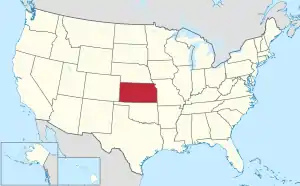 Kansas's location within the U.S. | |
| Coordinates: 38°42′N 96°36′W | |
| Country | |
| State | |
| Founded | February 11, 1859 |
| Named for | Thomas Morris |
| Seat | Council Grove |
| Largest city | Council Grove |
| Area | |
| • Total | 703 sq mi (1,820 km2) |
| • Land | 695 sq mi (1,800 km2) |
| • Water | 7.6 sq mi (20 km2) 1.1% |
| Population | |
| • Total | 5,386 |
| • Density | 7.7/sq mi (3.0/km2) |
| Time zone | UTC−6 (Central) |
| • Summer (DST) | UTC−5 (CDT) |
| Congressional district | 2nd |
| Website | MorrisCountyKS.org |
History
Early history
For many millennia, the Great Plains of North America was inhabited by nomadic Native Americans. From the 16th century to 18th century, the Kingdom of France claimed ownership of large parts of North America. In 1762, after the French and Indian War, France secretly ceded New France to Spain, per the Treaty of Fontainebleau. In 1802, Spain returned most of the land to France, but keeping title to about 7,500 square miles.
In 1803, most of the land for modern day Kansas was acquired by the United States from France as part of the 828,000 square mile Louisiana Purchase for 2.83 cents per acre. In 1848, after the Mexican–American War, the Treaty of Guadalupe Hidalgo with Mexico brought into the United States all or part of land for ten future states, including southwest Kansas. In 1854, the Kansas Territory was organized, then in 1861 Kansas became the 34th U.S. state.
19th century
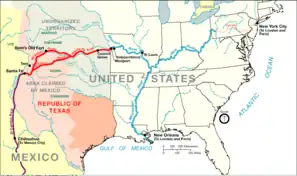

The county was established on ancient grounds of the Kaw American Indian tribe. Settlers and the Kaw lived in increasingly uneasy relationship as settlers encroached on native lands.
Council Grove, established by European Americans in 1825, was an important supply station on the Santa Fe Trail. The town was also the site of an encampment by John C. Fremont in 1845 and in 1849 the Overland Mail established a supply headquarters there.
From 1821 to 1866, the Santa Fe Trail was active across Morris County.[2]
The county was originally organized as Wise County in 1855. The county was named for Virginia Governor Henry A. Wise. When Wise presided over the hanging of abolitionist John Brown at Harpers Ferry in 1859, abolition supporters renamed it to Morris County in honor of Thomas Morris, a former United States Senator from Ohio who was an opponent of slavery.
From 1846 to 1873, a Kaw Indian Reservation was centered around Council Grove, Kansas on 20 square miles of land.[3] In 1851, the Methodist Church established an Indian Mission in Morris County.
Between 1877 and 1879, Benjamin "Pap" Singleton, a former slave who escaped to freedom in 1846, staked out a settlement in Morris County for freedmen known as "Exodusters". Thousands of families migrated from the post-Reconstruction South to seek more opportunities and better living conditions in the Midwest.
In 1887, the Chicago, Kansas and Nebraska Railway built a main line from Topeka to Herington.[4] This main line connected Topeka, Valencia, Willard, Maple Hill, Vera, Paxico, McFarland, Alma, Volland, Alta Vista, Dwight, White City, Latimer, Herington. The Chicago, Kansas and Nebraska Railway was foreclosed in 1891 and taken over by Chicago, Rock Island and Pacific Railway, which shut down in 1980 and reorganized as Oklahoma, Kansas and Texas Railroad, merged in 1988 with Missouri Pacific Railroad, merged in 1997 with Union Pacific Railroad. Most locals still refer to this railroad as the "Rock Island".
In 1887, Atchison, Topeka and Santa Fe Railway built a branch line from Neva (3 miles west of Strong City) to Superior, Nebraska. This branch line connected Strong City, Neva, Rockland, Diamond Springs, Burdick, Lost Springs, Jacobs, Hope, Navarre, Enterprise, Abilene, Talmage, Manchester, Longford, Oak Hill, Miltonvale, Aurora, Huscher, Concordia, Kackley, Courtland, Webber, Superior. At some point, the line from Neva to Lost Springs was pulled but the right of way has not been abandoned. This branch line was originally called "Strong City and Superior line" but later the name was shortened to the "Strong City line". In 1996, the Atchison, Topeka and Santa Fe Railway merged with Burlington Northern Railroad and renamed to the current BNSF Railway.
20th century
The National Old Trails Road, also known as the Ocean-to-Ocean Highway, was established in 1912, and was routed through Herington, Delavan, and Council Grove.
Geography
According to the U.S. Census Bureau, the county has a total area of 703 square miles (1,820 km2), of which 695 square miles (1,800 km2) is land and 7.6 square miles (20 km2) (1.1%) is water.[5]
Adjacent counties
- Geary County (north)
- Wabaunsee County (northeast)
- Lyon County (southeast)
- Chase County (south)
- Marion County (southwest)
- Dickinson County (west)
Demographics

| Census | Pop. | Note | %± |
|---|---|---|---|
| 1860 | 770 | — | |
| 1870 | 2,225 | 189.0% | |
| 1880 | 9,265 | 316.4% | |
| 1890 | 11,381 | 22.8% | |
| 1900 | 11,967 | 5.1% | |
| 1910 | 12,397 | 3.6% | |
| 1920 | 12,005 | −3.2% | |
| 1930 | 11,859 | −1.2% | |
| 1940 | 10,363 | −12.6% | |
| 1950 | 8,485 | −18.1% | |
| 1960 | 7,392 | −12.9% | |
| 1970 | 6,432 | −13.0% | |
| 1980 | 6,419 | −0.2% | |
| 1990 | 6,198 | −3.4% | |
| 2000 | 6,104 | −1.5% | |
| 2010 | 5,923 | −3.0% | |
| 2020 | 5,386 | −9.1% | |
| U.S. Decennial Census[6] 1790-1960[7] 1900-1990[8] 1990-2000[9] 2010-2020[1] | |||
2000 census
As of the census[10] of 2000, there were 6,104 people, 2,539 households, and 1,777 families residing in the county. The population density was 9 people per square mile (3.5 people/km2). There were 3,160 housing units at an average density of 4 per square mile (1.5/km2). The racial makeup of the county was 97.49% White, 0.34% Black or African American, 0.33% Native American, 0.23% Asian, 0.02% Pacific Islander, 0.70% from other races, and 0.88% from two or more races. 2.23% of the population were Hispanic or Latino of any race.
There were 2,539 households, out of which 30.20% had children under the age of 18 living with them, 60.70% were married couples living together, 6.60% had a female householder with no husband present, and 30.00% were non-families. 28.00% of all households were made up of individuals, and 14.90% had someone living alone who was 65 years of age or older. The average household size was 2.37 and the average family size was 2.90.
In the county, the population was spread out, with 25.20% under the age of 18, 5.60% from 18 to 24, 23.90% from 25 to 44, 24.30% from 45 to 64, and 21.00% who were 65 years of age or older. The median age was 42 years. For every 100 females there were 97.00 males. For every 100 females age 18 and over, there were 93.30 males.
The median income for a household in the county was $32,163, and the median income for a family was $39,717. Males had a median income of $28,912 versus $21,239 for females. The per capita income for the county was $18,491. About 6.70% of families and 9.00% of the population were below the poverty line, including 10.40% of those under age 18 and 13.30% of those age 65 or over.
Government
Presidential elections
| Year | Republican | Democratic | Third party | |||
|---|---|---|---|---|---|---|
| No. | % | No. | % | No. | % | |
| 2020 | 2,124 | 73.27% | 729 | 25.15% | 46 | 1.59% |
| 2016 | 1,820 | 69.36% | 601 | 22.90% | 203 | 7.74% |
| 2012 | 1,773 | 69.20% | 718 | 28.02% | 71 | 2.77% |
| 2008 | 1,875 | 66.00% | 907 | 31.93% | 59 | 2.08% |
| 2004 | 1,961 | 66.79% | 931 | 31.71% | 44 | 1.50% |
| 2000 | 1,599 | 60.55% | 882 | 33.40% | 160 | 6.06% |
| 1996 | 1,553 | 51.96% | 965 | 32.29% | 471 | 15.76% |
| 1992 | 1,071 | 34.43% | 957 | 30.76% | 1,083 | 34.81% |
| 1988 | 1,682 | 58.12% | 1,165 | 40.26% | 47 | 1.62% |
| 1984 | 2,240 | 72.19% | 820 | 26.43% | 43 | 1.39% |
| 1980 | 1,933 | 65.55% | 810 | 27.47% | 206 | 6.99% |
| 1976 | 1,698 | 54.74% | 1,337 | 43.10% | 67 | 2.16% |
| 1972 | 2,471 | 76.12% | 704 | 21.69% | 71 | 2.19% |
| 1968 | 1,938 | 60.00% | 976 | 30.22% | 316 | 9.78% |
| 1964 | 1,683 | 50.65% | 1,605 | 48.30% | 35 | 1.05% |
| 1960 | 2,413 | 67.40% | 1,148 | 32.07% | 19 | 0.53% |
| 1956 | 2,677 | 68.55% | 1,208 | 30.93% | 20 | 0.51% |
| 1952 | 3,263 | 74.11% | 1,124 | 25.53% | 16 | 0.36% |
| 1948 | 2,285 | 56.46% | 1,701 | 42.03% | 61 | 1.51% |
| 1944 | 2,628 | 62.11% | 1,584 | 37.44% | 19 | 0.45% |
| 1940 | 3,276 | 61.64% | 1,992 | 37.48% | 47 | 0.88% |
| 1936 | 2,751 | 49.32% | 2,805 | 50.29% | 22 | 0.39% |
| 1932 | 2,566 | 49.69% | 2,452 | 47.48% | 146 | 2.83% |
| 1928 | 3,830 | 79.54% | 929 | 19.29% | 56 | 1.16% |
| 1924 | 3,089 | 64.70% | 1,040 | 21.78% | 645 | 13.51% |
| 1920 | 3,001 | 66.19% | 1,467 | 32.36% | 66 | 1.46% |
| 1916 | 2,289 | 45.73% | 2,577 | 51.48% | 140 | 2.80% |
| 1912 | 487 | 16.49% | 1,144 | 38.73% | 1,323 | 44.79% |
| 1908 | 1,788 | 57.53% | 1,273 | 40.96% | 47 | 1.51% |
| 1904 | 2,007 | 70.32% | 702 | 24.60% | 145 | 5.08% |
| 1900 | 1,650 | 55.15% | 1,326 | 44.32% | 16 | 0.53% |
| 1896 | 1,484 | 49.92% | 1,456 | 48.97% | 33 | 1.11% |
| 1892 | 1,416 | 50.90% | 0 | 0.00% | 1,366 | 49.10% |
| 1888 | 1,612 | 58.72% | 840 | 30.60% | 293 | 10.67% |
Like all of Kansas outside the eastern cities, Morris County is powerfully Republican. Only two Democratic presidential candidates have ever carried the county – Woodrow Wilson in 1916 and Franklin D. Roosevelt in 1936, who ironically was opposing Kansan governor Alf Landon. Ross Perot did tie with George H. W. Bush in the county in 1992.
Laws
Following amendment to the Kansas Constitution in 1986, the county remained a prohibition, or "dry", county until 1992, when voters approved the sale of alcoholic liquor by the individual drink with a 30 percent food sales requirement.[12]
Education
Unified school districts
- School district office in neighboring county
Communities
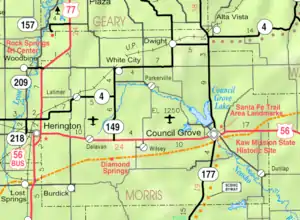
‡ means a community has portions in an adjacent county. † means a community is designated a Census-Designated Place (CDP) by the United States Census Bureau.
Cities
- Council Grove (county seat)
- Dunlap
- Dwight
- Herington‡
- Latimer
- Parkerville
- White City
- Wilsey
Unincorporated communities
Ghost towns
Townships
Morris County is divided into eleven townships. The cities of Council Grove and Herington are considered governmentally independent and are excluded from the census figures for the townships. In the following table, the population center is the largest city (or cities) included in that township's population total, if it is of a significant size.
| Township | FIPS | Population center |
Population | Population density /km2 (/sq mi) |
Land area km2 (sq mi) | Water area km2 (sq mi) | Water % | Geographic coordinates |
|---|---|---|---|---|---|---|---|---|
| Highland | 31975 | 94 | 1 (3) | 93 (36) | 0 (0) | 0.03% | 38°44′48″N 96°45′52″W | |
| Overland | 53750 | 60 | 1 (2) | 88 (34) | 0 (0) | 0.01% | 38°48′18″N 96°51′44″W | |
| Township 1 | 71202 | 551 | 2 (4) | 356 (138) | 1 (0) | 0.28% | 38°36′23″N 96°25′34″W | |
| Township 2 | 71206 | 688 | 3 (7) | 270 (104) | 12 (5) | 4.37% | 38°42′42″N 96°30′4″W | |
| Township 3 | 71210 | 503 | 5 (12) | 109 (42) | 0 (0) | 0.06% | 38°49′54″N 96°34′57″W | |
| Township 4 | 71214 | 252 | 2 (4) | 155 (60) | 0 (0) | 0.02% | 38°47′19″N 96°39′17″W | |
| Township 5 | 71218 | 686 | 7 (19) | 93 (36) | 0 (0) | 0.02% | 38°48′24″N 96°45′4″W | |
| Township 6 | 71222 | 111 | 1 (4) | 78 (30) | 0 (0) | 0.18% | 38°44′5″N 96°51′46″W | |
| Township 7 | 71227 | 258 | 2 (4) | 170 (66) | 0 (0) | 0.10% | 38°39′22″N 96°49′44″W | |
| Township 8 | 71232 | 212 | 1 (3) | 186 (72) | 0 (0) | 0.08% | 38°33′56″N 96°48′36″W | |
| Township 9 | 71237 | 368 | 2 (5) | 202 (78) | 0 (0) | 0.08% | 38°38′2″N 96°39′28″W |
See also
- Community information for Kansas
References
- "QuickFacts; Morris County, Kansas; Population, Census, 2020 & 2010". United States Census Bureau. Archived from the original on August 16, 2021. Retrieved August 16, 2021.
- History of the Cottonwood Crossing Chapter, Santa Fe Trail Association.
- Morris County History; legendsofkansas.com
- "Rock Island Rail History". Archived from the original on June 19, 2011. Retrieved April 20, 2011.
- "US Gazetteer files: 2010, 2000, and 1990". United States Census Bureau. February 12, 2011. Retrieved April 23, 2011.
- "U.S. Decennial Census". United States Census Bureau. Retrieved July 27, 2014.
- "Historical Census Browser". University of Virginia Library. Retrieved July 27, 2014.
- "Population of Counties by Decennial Census: 1900 to 1990". United States Census Bureau. Retrieved July 27, 2014.
- "Census 2000 PHC-T-4. Ranking Tables for Counties: 1990 and 2000" (PDF). United States Census Bureau. Archived (PDF) from the original on March 27, 2010. Retrieved July 27, 2014.
- "U.S. Census website". United States Census Bureau. Retrieved January 31, 2008.
- "Dave Leip's Atlas of U.S. Presidential Elections".
- "Map of Wet and Dry Counties". Alcoholic Beverage Control, Kansas Department of Revenue. November 2006. Archived from the original on October 8, 2007. Retrieved December 26, 2007.
- Notes
Further reading
- County
- The Story of Council Grove on the Santa Fe Trail; 2nd Ed; Lalla Maloy Brigham; 176 pages; 1921.
- Handbook of Morris County, Kansas; C.S. Burch Publishing Co; 24 pages; 1883.
- Standard Atlas of Morris County, Kansas; Geo. A. Ogle & Co; 63 pages; 1923.
- Standard Atlas of Morris County, Kansas; Geo. A. Ogle & Co; 53 pages; 1901.
- Trails
- The Story of the Marking of the Santa Fe Trail by the Daughters of the American Revolution in Kansas and the State of Kansas; Almira Cordry; Crane Co; 164 pages; 1915. (Download 4MB PDF eBook)
- The National Old Trails Road To Southern California, Part 1 (LA to KC); Automobile Club Of Southern California; 64 pages; 1916. (Download 6.8MB PDF eBook)
External links
- County
- Maps